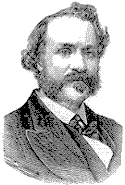
















I shall confine myself to examining Keely's theories and experiments in the light of today's scientific knowledge and attempt to explain what Keely did in plain modern English, as far as that is possible.
I first found out about Keely in the early 1970's when I came across Clara Bloomfield Moore's book. I found it both fascinating and cumbersome. Keely's comments appeared at first inspection as pseudo scientific gibberish intended to cull huge funds from gullible investors. On closer inspection though a pattern emerged, that in its logic and order is equal to any scientific treatise, especially when one considers that the man was endeavoring to impart a sophisticated body of knowledge to a world that was still trying to come to grips with the steam engine.
I was taken aback by one of Keely's comments when asked about his 'secrets'. He said: "....as to secrets, I don't have any". I believed him. I proceeded to look at his writings (what little there is left) in the light of seeing him as a man honestly trying to elucidate a monumental discovery to a world that simply wasn't ready for it.
Modern science essentially holds that matter is held together by enormous electrical forces that can be interrupted by bombardment with particles, thus liberating energy. This is certainly true for certain highly unstable elements such as plutonium, but try doing it with lead.
Based on his experiments in vibratory physics Keely thought otherwise. Keely found that pure matter is highly unstable and that stability is the result of interference patterns set up by the interaction of different molecular groupings vibrating at incompatible frequencies.
Fundamentally, Keely's approach was simple.
We know we can cancel a waveform by levelling against it the same waveform that has been inverted.
So Keely set about doing just that. He identified the incompatible waveforms that interfered with the pure fundamental waveform of the body under study and proceeded to cancel them out by by tuning the mass he operated upon to as pure a note he could manage and an arrangement of acoustic resonators of opposite value to the incompatible frequencies that were left.
He called this his 'system of graduation'. There is more to it than that, but for the moment it will suffice. The subject of graduation will be covered in greater detail in a later chapter.
In his view this created a state where ALL FORCES were held in perfect balance.
On a finely balanced scale, no matter how heavy the load on each side, it takes only a minuscule amount of change on either side to disturb equilibrium.
Keely reasoned that disturbance of equilibrium in the body under study could be influenced by changing the amplitude of selected sections in the fundamental pure frequency pattern.
We know that a resonant body will accept energy at its own level of resonance but reject energy at frequencies far removed from its own level of resonance. This is also true for the harmonics of that fundamental frequency.
By an arrangement of acoustic resonators, carefully tuned to the precise frequency of the harmonic he wanted to stimulate, he managed to achieve this.
So far we are still on safe ground as far as contemporary science is concerned. Though very much simplified here for the sake of readability this is essentially what Keely did.
What follows is extraordinary and not documented in any accepted scientific study I am aware of.
Keely claims that by changing the amplitude of certain segments of the wavepattern he could influence the cohesive forces between particles from an incredible denseness to complete disintegration. In other words he believed he had found a way to manipulate gravity.
Keely, vehemently claimed that bodies of 'pure concordant harmony' did not exist in nature, in fact could not exist in nature, and that such pure states had to be induced by artifice. He further claimed that this state had to be created before any manipulation could take place.
The rest of his writings concern themselves with technical difficulties encountered and identifying effective frequencies and ratios of amplitude in order to achieve specific effects.
For our purpose it is not necessary to examine these aspects here.
Next Chapter:
KEELY'S DIFFICULTY.
Contact:
Hans von Lieven, copyright 1999